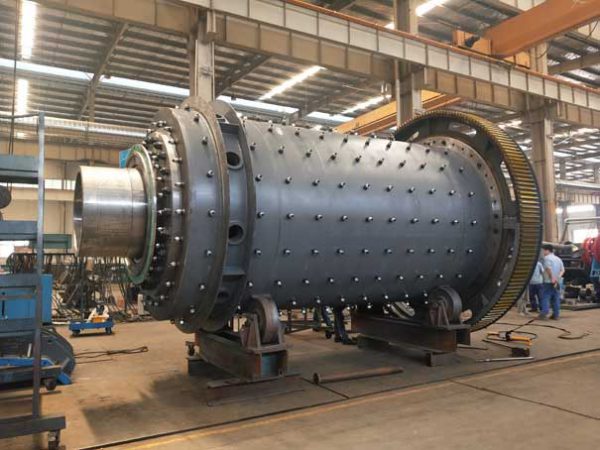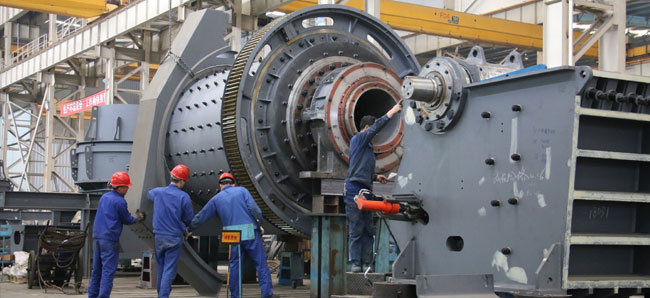The grinding methods of ball mills can be divided into two types: dry grinding and wet grinding. Wet grinding has a wide range of applications. Wet grinding can be used for most minerals. The application range of dry grinding is smaller, but some materials can only be used for dry grinding grind. Here I will tell you about the principle and scope of application of the dry and wet grinding of the ball mill.

The working principle of dry grinding and wet grinding of ball mill
The main equipment for dry grinding of a ball mill is a dry ball mill. The structure of a dry ball mill is much more complicated than that of a wet ball mill. It must be equipped with an induced draft device, a dust exhaust pipe and a dust collector, which is determined by its working principle. Dry grinding of the ball mill requires that the material in the mill is dry, and no water or other liquids can be added. The material is ground by the medium of the ball mill in the mill, and the products that meet the requirements are carried out by the wind or airflow.
The main equipment of the wet grinding of the ball mill is a wet ball mill. The structure of the wet ball mill is simple. There is no need to add too many auxiliary accessories. Water or absolute ethanol needs to be added during the grinding process. During the grinding operation, the large materials will be affected by the impact of the ball milling medium. Cracks are generated under the action of grinding, and the cracks gradually increase and deepen, and finally the materials are separated from the cracks, so as to achieve the effect of grinding the bulk materials into smaller ones.
The material and the grinding medium are mixed together and collide with each other and squeeze. If it is dry grinding, because there is no material blocking in the cracks, it is very likely that the cracks will be squeezed smaller and smaller during the extrusion process, which will cause grinding. The mine efficiency is low and the material separation speed is slow; and if it is wet grinding, when small cracks appear in large minerals, the fluidity of the water will force the water flow into the cracks, which will block it, and then pass the impact of the grinding medium. And squeezing, it will gradually increase the cracks, and eventually the large pieces of material will be crushed, so the efficiency of wet grinding is high.

In addition to high grinding efficiency, wet grinding has the characteristics of low noise, fine and uniform grinding particle size, and less pollution to the working environment. The advantage of the dry grinding of the ball mill lies in the use of grate plate type mill tail discharge, the discharge speed is fast and smooth, there will be no belly up phenomenon, the cylinder does not need to be cooled, and the service life is long.
The above are the advantages of dry grinding and wet grinding, and there are disadvantages. The disadvantage of dry grinding is that there may be dead corners in the mill. Once the material enters the dead corner, it will not come out without the drive of water, and it will not be able to grind; the disadvantage of wet grinding. It is the process of dehydration and drying after grinding, which increases the cost.
It can be seen that dry grinding and wet grinding of ball mills have their own advantages and disadvantages, so which materials are they suitable for?
The scopes of application of ball mill dry grinding and wet grinding
Dry grinding: It is suitable for materials that react with water, such as cement, marble and other building stones. It may produce other substances when exposed to water, so it is not suitable for wet grinding. Some products require storage and sale in powder form. It is also suitable for dry grinding; in addition, because of the lack of water resources in some arid areas, dry grinding can also be used in order to save water;
Wet grinding: Wet grinding is suitable for most materials, all kinds of metal mines and non-metal mines. As long as they will not react with water and affect the quality of the finished product, wet grinding can be used. Common ones include copper and iron ore, molybdenum, phosphate, feldspar, fluorite, etc. The ratio of steel ball, material and water during wet grinding is 4:2:1 and the specific ratio need to be determined by grinding test.
The principle and scope of application of dry and wet milling of the above ball mills are discussed. When you choose, you still have to choose according to the nature and characteristics of the material, the requirements of the product, the working environment and other considerations. Of course, the most widely used one is still wet grind.

